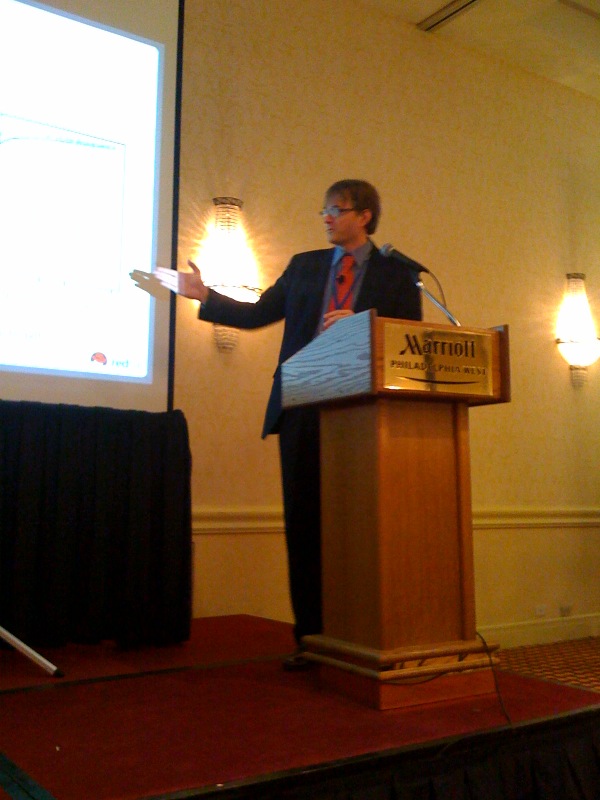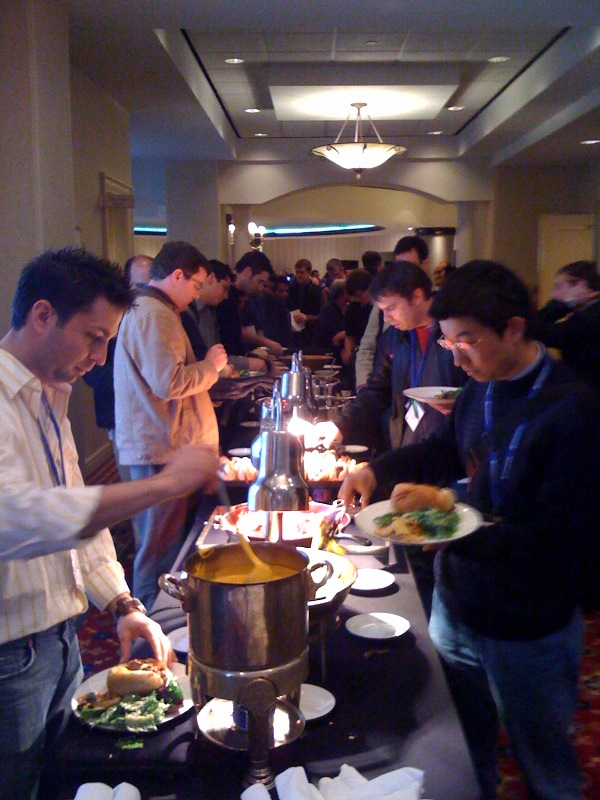 Unlike the last major expo to roll through the city, the Emerging Technology for the Enterprise conference was all business. The event, presented by Chariot Solutions, had a target audience of developers and IT managers, so serious businessman were rubbing elbows in the lunch line with young 20-something programmers in XKCD t-shirts. If you listened, you heard the names of management philosophies mentioned in the same breath as up and coming programming language, and yet, everybody was on the same page.
Unlike the last major expo to roll through the city, the Emerging Technology for the Enterprise conference was all business. The event, presented by Chariot Solutions, had a target audience of developers and IT managers, so serious businessman were rubbing elbows in the lunch line with young 20-something programmers in XKCD t-shirts. If you listened, you heard the names of management philosophies mentioned in the same breath as up and coming programming language, and yet, everybody was on the same page.
The day’s sessions were organized in “tracks.” Two of the five rooms were focused on development and programming. Another room was devoted strictly to topics pertaining to the AGILE development model. Cloud computing and management rounded out the other rooms. Until Technically Philly masters the art of omnipresence, we could only attend a few of the first day panels including the keynote by RedHat’s open source evangelist Michael Tiemann. We were also unable to swing by today for an anticipated keynote by Jascha Franklin-Hodge, CTO of Blue State Digital, which spearheaded Obama for America’s online initiatives. If you were able to attend, be sure to let us know your thoughts in our comments.
Our take on yesterday’s keynote and sessions after the jump.
Keynote: Exonovation – Leveraging Innovation from the Edge

Source: Michael Tiemann
For the opening hour of the conference, the only session was the keynote by Michael Tiemann, Vice President of Open Source Affairs at Red Hat. The head of open source at a company known for open source spoke exactly on the topic you would guess. The UPenn grad was entertaining and informative at the same time and a perfect fit to wake up audience in the morning. He peppered his speech with anecdotes that made a dry topic appeal to the senses. For example, Tiemann spoke of his time encouraging the Department of Defense to adopt Open Source. He passed along the statistic that proprietary software averages 30 lines of defective code per 1000 lines, while a scan of Linux found only 985 errors in five million lines.
“Imagine if you had 30 insurgents in your brigade,” Tiemann said.
Tiemann’s speech focused on the benefits of Open Source, and was full of reasons and research supporting Open Source initiatives. The majority of the audience did not need to be sold on the benefits of open source, but Tiemann was aiming more to give those attending ammunition to convert their coworkers and management.
He pointed to the growth of the efficiency in the steam engine once the patent was released and used Microsoft Vista as an example of the difficulty closed source software has in squashing bugs. Tiemann even showed research by Harvard Business School game theorists that proved what motivated Open Source developers to contribute to code. The talk was a sales pitch, but instead of peddling the newsest software package, Tiemann was advocating a new way of thinking about development and it was obvious that it was something he was passionate about. After all, he is literally the President of Open Source.
Session: Introduction to iPhone Development
After getting in the iPhone session a few minutes early, it was apparent that this was the most popular session of the first round. Attendees quickly filled up roughly 80 chairs and many were forced to stand in the back or sit on the floor with their laptops on the ground, ready to code along with presenter Bill Dudney. The interest is no surprise, iPhones have quickly become the new hot market for developers with many focusing on Apple’s phone full time.
The event’s description led attendees to believe that if they just programmed along with Dudney, they would have a working iPhone application. However the talk required some sort of programming background. If you were a businessman or, say, a journalism major, you were left unapologetically in the dust. Dudley quickly breezed through the iPhone Developers Kit cracking jokes about square brackets and settling debates about syntax and memory dumps. The presenter may have been moving too quickly for some, but the hour time frame was rather limiting, and Dudley was conscience of that. However, the Twitter-verse seemed to enjoy the session.
Session: Microsoft and Cloud Computing

The last event attended by Technically Philly was about Microsoft’s future strategy of cloud computing. The session was lead by De’Porres “D.P.” Brightful, Director of the Mid-Atlantic States. While he did his best to prevent the talk from sounding like a sales pitch, that is exactly what it became. That is not necessarily a bad thing, as Microsoft often gets cast as the lumbering giant who is too slow to realize emerging technologies. It was refreshing to hear straight talk directly from the company.
Brightful lived up to his name. He was extremely charismatic and easy-going, ready to take questions from an sometimes-hostile audience. Although, as a consumer, the talk did not have any direct impact on my computing, it was interesting to see Microsoft’s new direction. The company plans to “virtualize everything” and place as much data in the cloud as possible. Thus giving its customers flexibility in how it uses software. Microsoft believes that sticking everything in the cloud is not the answer, nor is desktop computer the way of the future. The company is aiming to strike a balance between the two. Given the company’s stranglehold on business software, it seems a no-brainer. And if Microsoft seems late to the game behind Google Apps or Amazon, that may have been their plan all along.
“Our real strategy has always been to enter an existing market, lower the cost and make it a commodity. Then we make gobs and gobs of money,” Brightful said with a laugh. He, and Microsoft believe that virtualization is the next commodity, and if Microsoft seems behind now, it’s only a matter of time before they will own the space.
Were you at the expo on Friday? Please let us know in the comments!







